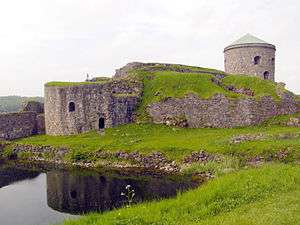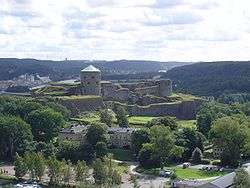Bohus Fortress
| Bohus Fortress | |
|---|---|
| Kungälv, Sweden | |
|
Bohus Fortress | |
| Site information | |
| Controlled by | Norway, Denmark–Norway, Sweden |
| Site history | |
| Built | 1308 |
| In use | 1308-1783 |
| Materials | Granite, brick, wood |
Bohus Fortress (also known as Baahus or Båhus, originally: Bagahus) lies along the old Norwegian–Swedish border in Kungälv, Bohuslän, Sweden, north east from Hisingen where the Göta river splits into two branches (20 km (12 mi) north of Gothenburg). It commands the surrounding area from a cliff 40 m (130 ft) high, with the river forming a natural moat around it.
Initial construction
The construction of Bohus Fortress (Norwegian: Båhus festning, Swedish: Bohus fästning) began in 1308 under King Haakon V Magnuson, king of Norway from 1299 to 1319.[1][2] Håkon V also initiated construction of Norwegian fortresses at Akershus and Vardøhus as part of a broader defensive policy. At the time Bohuslän (Båhuslen) was Norwegian territory and served as the main Norwegian defence against Sweden,[3] along the coast as well as the strong point for the Bohuslän region from 1308 to 1658.

Medieval castle
According to architect Guthorm Kavli:
By 1310, records show it was constructed, as normal for that period, out of granite and brick, perhaps under the guidance of Count Jacob of Halland. By 1450, it included a continuous surrounding wall, 3 metres thick at the base, with a height which varied from 8.5 to 13.5 metres, varying with the terrain. It was approximately rectangular, with four rectangular corner towers. At the eastern end there was a brick tower, and in the centre of the west side a gate house and drawbridge. Along the inside of the surrounding wall buildings were located which among other things included the 'Kings hall', the castle commander's residence, the chapel, the guardroom, the barracks and the kitchen. The fortress had secure vaulted positions, partly cut into the mountain, and beyond that strong outer-works. At the time Båhus was Norway's strongest fortress. The approaches were very difficult and the area to be defended was small, only 250 x 150 metres, so it did not require a large defensive force.[4]
Fortress

The fortress was attacked or besieged 14 times, but was never captured.[3] During the Northern Seven Years' War, in 1563–1570, it was seriously damaged. This occurred in 1566, when 250 Swedish soldiers successfully stormed the northeastern-most tower. The Norwegian commander sent in a volunteer to blow up the ammunition stores underneath the tower, killing the Swedes and repelling the attack. As a reward the family of the volunteer got a piece of land which is still owned by the descendants of this volunteer.
The Norwegians rebuilt the fortress of stone and brick, and reinforced it substantially. The reconstruction immediately after the war was directed by Hans Paaske (Påske) from the Netherlands.
In 1593–1604, similar to the construction then undertaken at Akershus in Oslo, Bohus was upgraded to a bastion fortress. A new outer fortification was raised. This construction was one of the early works of Hans van Steenwinckel, also from the Netherlands, who later became noted for his Dutch Renaissance style design in Denmark.
As Swedish invasions continuously threatened Norwegian Båhuslen during this time period, the improvement of the fortifications went on for years. For example, starting in the summer of 1651 and until the autumn of 1652, the Dutch engineer Isaac van Geelkerck supervised the construction of two corner towers along the south façade and a new ring wall that was constructed around the arsenal building.
Loss to Sweden
Under the terms of the Treaty of Roskilde in 1658, Denmark–Norway ceded the Danish provinces of Scania, Blekinge and Halland (the latter was agreed to belong to Sweden for a period of 30 years after the Peace of Brömsebro, but was given to Sweden permanently in the treaty of Roskilde) and the Norwegian provinces Trøndelag and Bohuslän (including the Bohus Fortress).[5]
After Denmark–Norway ceded the territory which included Bohus Fortress, Fredriksten Fortress was constructed in Fredrikshald on the newly established Norwegian-Swedish border.
Since the Bohus Fortress no longer lay on the border, it was of small use to Sweden,[5] which relied on the existing Älvsborg fortress at Gothenburg and the new Carlsten Fortress built at Marstrand.
Prison
Instead the fortress was used as a prison. The most noted prisoner was the radical pietist Thomas Leopold, who spent 42 years of his life behind bars, 32 of those at Bohus, for his alleged heresies. His stone-clad cell still exists in the castle.[5]
Modern times
At the end of the 18th century it was decided that the now unused fortress should be demolished. Demolition crews worked at the fortress for two months, after that the money allocated for the job had run out. Residents of the nearby town of Kungälv used the dressed stone from the fortress to build houses.[5] However, much of the fortress is still intact, including the large northern tower, Fars hatt ("Father's hat"). As of 2015, the fortress is a museum open to visitors during summer.[6]

References
- ↑ Linge, Lars, ed. (2001). Nordiska möten [Nordic meetings] (in Swedish). Kungälv: Fören. Kungälvs musei vänner. ISBN 91-631-0999-9.
- ↑ Behn, Andres (1995). Kongahälla: sagor och årtal [Kongahälla: tales and dates] (in Swedish). Gothenburg: Krönikeförl.
- 1 2 "Bohus fästning". www.sfv.se. National Property Board of Sweden. Retrieved 6 August 2015.
- ↑ Kavli, Guthom (1987). Norges festninger: fra Fredriksten til Vardøhus [Norway's fortresses: from Fredriksten to Vardøhus] (in Norwegian). Oslo: Universitetsforlaget. ISBN 82-00-18430-7.
- 1 2 3 4 Ringbom, Nina. "Bohus fästning, Sverige". www.slottsguiden.info. Nina Ringbom. Retrieved 6 August 2015.
- ↑ "Bohus Fästning" [Bohus Fortress]. www.kungalv.se. Kungälv Municipality. Archived from the original on 13 February 2014. Retrieved 6 August 2015.
External links
| Wikimedia Commons has media related to Bohus fästning. |
Coordinates: 57°51′45″N 11°59′55″E / 57.86250°N 11.99861°E
